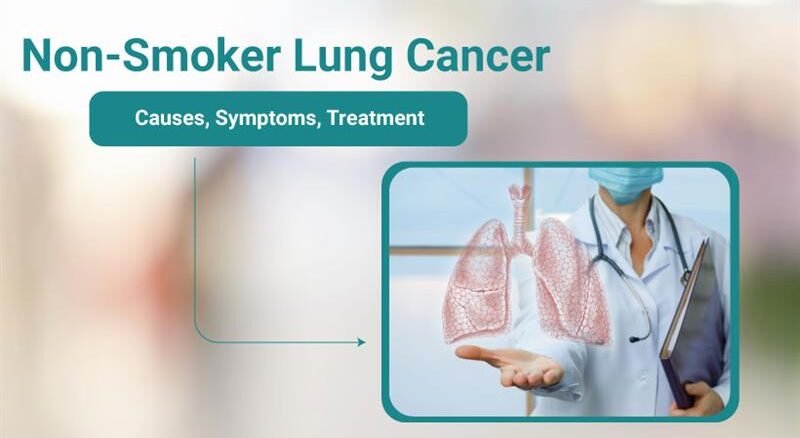When people hear the word “lung cancer,” they often think of smoking as the main cause. While it’s true that smoking is the biggest risk factor, many people who have never smoked a single cigarette can still develop lung cancer. This condition is called non-smoker lung cancer, and it’s becoming increasingly recognised by doctors and researchers around the world, including experienced oncologists like Dr. Satish Sharma.
Let’s understand what causes lung cancer in non-smokers, how it shows up, and what treatment options are available.
What Causes Lung Cancer in Non-Smokers?
It may seem surprising, but around 15–20% of lung cancer patients have never smoked. So, what exactly causes it in non-smokers? Several other risk factors can lead to lung cancer even without tobacco exposure:
- Air Pollution:
Long-term exposure to polluted air, especially in cities, can increase the risk of lung cancer. Tiny harmful particles enter the lungs and cause chronic inflammation or DNA damage. - Secondhand Smoke:
Breathing in smoke from others who smoke nearby can still affect lung tissues. This passive smoking is a major cause of lung cancer in families of smokers. - Radon Gas Exposure:
Radon is a naturally occurring gas that can seep into homes through cracks in the ground. Continuous exposure over the years can damage lung cells and lead to cancer. - Genetic Mutations:
Some people are born with genetic changes that increase their risk. In non-smokers, mutations like EGFR, ALK, or ROS1 are often found. These mutations can trigger uncontrolled cell growth in the lungs. - Occupational Hazards:
People working in environments with asbestos, diesel exhaust, or other chemical fumes have a higher chance of developing lung cancer even if they don’t smoke. - Family History:
If a close relative has had lung cancer, your risk may be slightly higher, even without smoking.
According to Dr. Satish Sharma, understanding these risk factors is essential, especially for patients who assume lung cancer only happens to smokers. Identifying the cause helps in planning a more personalised and effective treatment.
What are the Symptoms of Lung Cancer in Non-Smokers?
Lung cancer in non-smokers often goes unnoticed for a long time because early symptoms are mild or mistaken for common illnesses. Here are the signs to watch out for:
- Persistent cough that doesn’t go away
- Shortness of breath or wheezing
- Chest pain or discomfort
- Hoarseness or voice change
- Coughing up blood (even small amounts)
- Unexplained weight loss and fatigue
- Repeated lung infections like pneumonia or bronchitis
In non-smokers, cancer is often found in the outer regions of the lungs, which may not cause symptoms until it has grown larger or spread. Therefore, early medical attention for unexplained respiratory symptoms is extremely important.
How is Non-Smoker Lung Cancer Diagnosed and Treated?
The diagnosis process for non-smoker lung cancer is like other types, but often involves more targeted testing to identify genetic mutations.
Diagnosis usually includes:
- Chest X-ray or CT scan: to detect any abnormal masses in the lungs.
- Biopsy: a small sample of lung tissue is taken to confirm cancer.
- Molecular testing: helps identify gene mutations like EGFR, ALK, or KRAS, which guide targeted therapy.
Once diagnosed, treatment depends on the cancer’s stage, type, and genetic profile.
Here are the main treatment options:
- Targeted Therapy:
This is one of the most effective treatments for non-smoker lung cancer. It uses drugs that specifically target the genetic mutations driving cancer growth. For example, EGFR inhibitors are commonly used in non-smokers with this mutation. - Immunotherapy:
This treatment strengthens the immune system to recognise and fight cancer cells. It has shown great promise for patients who don’t respond well to chemotherapy. - Chemotherapy:
Traditional chemotherapy may still be used, especially when targeted or immunotherapy isn’t suitable. - Surgery:
If the tumour is small and hasn’t spread, removing part of the lung through surgery can be curative. - Radiation Therapy:
Used when surgery isn’t possible or to kill remaining cancer cells after surgery.
Dr. Satish Sharma, with his expertise in oncology, emphasises a personalised treatment approach. By identifying the exact cause and genetic makeup of the cancer, he ensures patients receive the most suitable and effective therapy with minimal side effects.
Can Non-Smoker Lung Cancer Be Prevented?
While you can’t control all risk factors, you can still reduce your chances:
- Avoid secondhand smoke: Stay away from environments where people smoke.
- Check for radon gas: Especially if you live in an old building or a basement-level home.
- Limit exposure to pollutants: Use air purifiers indoors and wear masks in polluted areas.
- Eat a balanced diet: Foods rich in antioxidants (like fruits and green vegetables) help protect lung tissues.
- Regular check-ups: If you have a family history or work in a risky environment, talk to your doctor about regular lung screenings.
Conclusion
Non-smoker lung cancer is a serious but often misunderstood condition. It reminds us that lung cancer is not just a smoker’s disease; it can affect anyone. Early detection, lifestyle precautions, and personalised medical care are the best ways to fight it.
With advanced treatments and accurate diagnosis, patients today have better outcomes than ever before. Under the guidance of experts like Dr. Satish Sharma, many non-smoker lung cancer patients lead fulfilling lives after treatment.
If you experience persistent cough, chest pain, or breathing issues, don’t ignore them. Seeking timely medical advice and early action can make all the difference.

